The restaurant industry faces persistent turnover and burnout, prompting operators to explore the four-day workweek as a potential solution.
By condensing full-time hours into four days, this model aims to improve work-life balance — but can it truly help retain staff in such a demanding environment?
This article examines whether a four-day workweek improves retention in the restaurant sector, using real-world trials, industry data and insights from workforce studies.
What Is a 4-Day Workweek?
The four-day workweek is a flexible scheduling model that condenses a full-time workload — typically 40 hours — into four days instead of five.
In restaurants, this often means four 10-hour shifts per week, giving employees an extra day off without reducing pay or total hours.
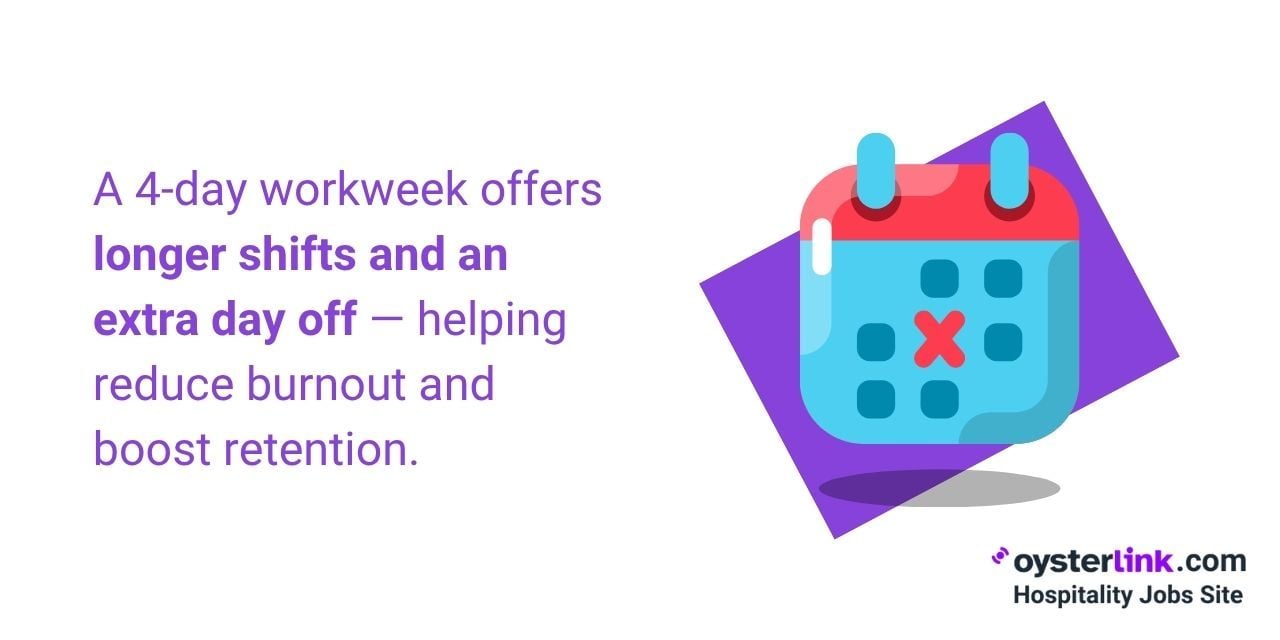
While the concept isn’t new, it has gained renewed attention as businesses look for ways to address burnout, improve mental health and retain talent — especially in industries like hospitality that struggle with high turnover.
What sets the current movement apart is the growing body of real-world trials showing that shorter workweeks can deliver meaningful results without sacrificing performance.
Case Study: Shake Shack’s 4-Day Workweek Pilot
One of the first major U.S. restaurant brands to experiment with this model was Shake Shack.
In 2020, the company piloted a four-day workweek for salaried managers in select locations. The goal was to reduce burnout, improve work-life balance and make management roles more attractive in a tight labor market.
Feedback from the pilot was overwhelmingly positive. Managers reported feeling more energized, enjoyed having more time for family and even saved on commuting and childcare costs.
The change also had a noticeable impact on recruitment, with a boost in job applications at pilot locations.
Although Shake Shack expanded the program initially, the initiative was eventually paused by 2022 due to challenges with scaling it system-wide.
According to a report from Restaurant Dive, the operational complexity — like coordinating schedules and maintaining service levels across multiple stores — was the primary barrier, not lack of interest or effectiveness.
This complexity made it difficult to balance reduced manager hours with the need to keep restaurants running smoothly.
Still, the trial underscored the four-day workweek’s potential as a powerful tool for improving retention and drawing in top talent, even in a fast-paced restaurant environment.
Supporting Evidence: The UK 4-Day Workweek Trial
Beyond individual companies, larger trials have demonstrated the viability of the four-day workweek across various sectors — including hospitality.
One of the most influential studies was conducted in the U.K. in 2022, involving 61 various types of companies ranging from marketing firms to restaurants and service-based businesses.
Over six months, these organizations adopted the 100–80–100 model: 100% of pay, 80% of the time, and 100% of expected output. The results were striking:
- Employee turnover dropped by 57%.
- 92% of companies said they would continue the four-day schedule after the trial.
- 71% of employees reported lower burnout levels.
- 39% said they felt less stressed.
- Productivity was either maintained or improved in the majority of participating companies.
These findings are particularly relevant for Restaurant Managers grappling with burnout, unpredictable scheduling and staffing shortages.
They reinforce the idea that reducing days worked — without cutting hours or pay — can lead to measurable improvements in employee satisfaction and loyalty.
As more restaurants look beyond short-term fixes to long-term staffing strategies, the four-day workweek is emerging not just as a novelty, but as a serious contender in the fight against high turnover.
More Countries Testing and Implementing 4-Day Workweeks
The concept of a four-day workweek is gaining traction globally, with several countries conducting trials to assess its feasibility and benefits.
- Iceland: Between 2015 and 2019, Iceland conducted trials reducing the workweek from 40 hours to 35-36 hours without a reduction in pay. The results were overwhelmingly positive, with 42% of workers on shorter hours said it reduced personal stress, while only 6% said it increased.
- Belgium: In 2022, Belgium passed legislation allowing employees to request a four-day workweek, providing greater flexibility in work arrangements.
- Spain: The Spanish government launched a pilot program in 2021 to test the effectiveness of a four-day workweek, aiming to improve productivity and employee well-being.
These international examples demonstrate the growing interest and potential benefits of reduced workweeks across various industries, including hospitality.
How a 4-Day Workweek May Improve Restaurant Retention
A shorter workweek isn’t just about giving employees more time off — it can directly impact how long they stay. This section explores the ways a four-day schedule may help reduce turnover by improving morale, mental health and productivity.
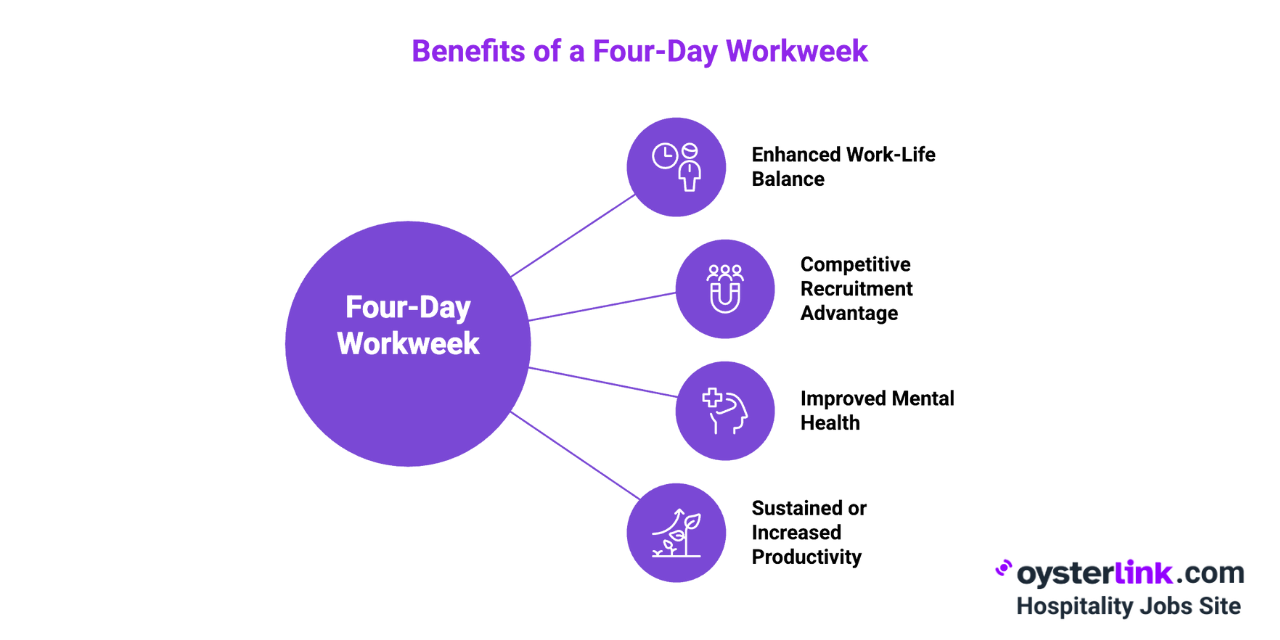
1. Enhanced Work-Life Balance
Restaurant employees often endure long hours, late nights and weekend shifts, making it challenging to maintain a healthy personal life.
Implementing a four-day workweek can offer staff an additional day to rest, engage in personal activities or manage other responsibilities, potentially leading to increased job satisfaction and reduced burnout.
2. Competitive Recruitment Advantage
In a labor market where attracting and retaining skilled workers is increasingly competitive, offering a four-day workweek can serve as a compelling incentive.
While specific statistics on applicant preferences were not detailed in the U.K. trial, the overall positive outcomes suggest that such flexible scheduling can enhance an employer's appeal.
Younger workers, in particular, often prioritize flexibility and work-life balance, making the four-day workweek an attractive proposition.
3. Improved Mental Health and Reduced Absenteeism
The same UK study reported a 65% reduction in sick and personal days among employees working a four-day week.
Additionally, participants noted decreases in anxiety, fatigue, and sleep issues, alongside improvements in mental and physical health. In the high-pressure environment of the restaurant industry, these health benefits can lead to fewer call-outs and a more reliable workforce.
4. Sustained or Increased Productivity
Concerns about reduced productivity with fewer working days are common; however, evidence suggests otherwise.
Microsoft Japan's implementation of a four-day workweek resulted in a 40% increase in productivity, measured by sales per employee.
The company also observed a 23% reduction in electricity costs and a 59% decrease in paper printing.
These findings indicate that with thoughtful planning, a condensed workweek can maintain or even boost productivity levels.
Employee Preferences: What Hospitality Workers Actually Want
Understanding employee preferences is crucial for implementing effective retention strategies. Recent studies highlight that flexibility and work-life balance are top priorities for workers, especially among younger generations.
- A 2023 Deloitte survey revealed that work-life balance remains a top priority for Gen Zs and millennials, with flexible work arrangements and part-time jobs growing in popularity.
- According to Gallup, the most appealing flexibility includes the ability to choose which days you work, more PTO and vacation time, and a four-day workweek.
These insights suggest that adopting flexible scheduling models, such as the four-day workweek, can align with employee desires and potentially improve retention rates.
Challenges of Implementing a 4-Day Workweek in Restaurants
While the benefits are promising, the restaurant industry faces unique operational hurdles that can make a four-day schedule difficult to adopt. Here are the most common challenges to consider before making the shift.
1. Scheduling and Coverage
Restaurants typically operate seven days a week, often with extended hours, necessitating consistent staffing. Transitioning to a four-day workweek requires meticulous scheduling to ensure coverage during peak times.
This might involve hiring additional part-time staff or adopting rotating schedules to maintain service quality.
2. Longer Shifts
Condensing a 40-hour workweek into four days means 10-hour shifts, which can be physically demanding, especially for roles involving constant movement, such as Servers, Cooks and Dishwashers.
Extended shifts may lead to fatigue, potentially impacting employee performance and satisfaction.
3. Operational Complexity
Implementing a four-day workweek across all restaurant operations can be complex. Shake Shack's pilot program for salaried managers showed initial promise but was eventually paused due to challenges in scaling the model nationally.
Operational variability, such as fluctuating customer demand and staffing needs, complicates consistent scheduling.
Alternative 4-Day Workweek Models for Restaurants
Not every restaurant can adopt a strict four-day, 40-hour schedule. This section outlines flexible adaptations —like staggered shifts or role-specific changes — that can still offer the benefits of reduced workweeks without disrupting operations.
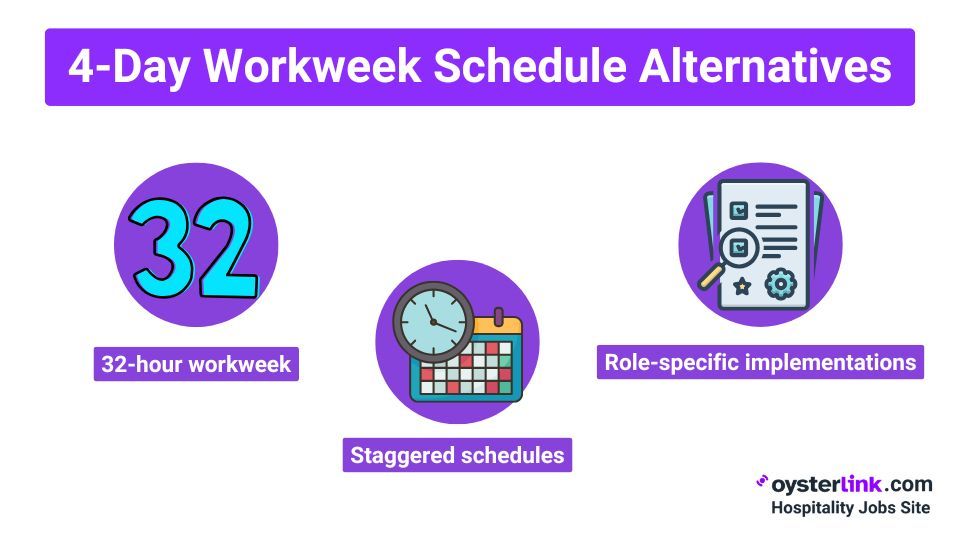
- 32-Hour Workweek: Employees work four 8-hour days without a reduction in pay. While this model has shown benefits in white-collar settings, it may not be financially feasible for all restaurants.
- Staggered Schedules: Implement rotating four-day schedules where staff have different days off, ensuring continuous coverage while providing extended rest periods.
- Role-Specific Implementation: Apply the four-day workweek to specific roles, such as back-of-house staff or salaried managers, while offering other flexible options to front-of-house employees.
Cost-Benefit Analysis of a 4-Day Workweek
A four-day workweek can offer real value — but it also comes with trade-offs. This section weighs the potential savings against the risks and operational adjustments involved in implementation.
Potential Costs:
- Staffing complexity: Coordinating schedules to ensure adequate coverage can be challenging.
Overtime risks: Longer shifts may lead to overtime pay, increasing labor costs. - Operational Adjustments: Menus, prep times, and shift handovers may require revisions to accommodate new schedules.
Potential Benefits:
- Reduced turnover: Lowering employee churn by even 10–20% can result in significant savings, considering the average cost of replacing a restaurant employee is approximately $5,864.
- Enhanced recruitment: Offering a four-day workweek can differentiate a restaurant in a competitive hiring market.
- Increased productivity: Employees may be more focused and efficient during their shifts, leading to better performance.
Does a 4-Day Workweek Improve Retention?
Yes, a four-day workweek can boost restaurant staff retention. Studies show it improves well-being, reduces absenteeism and maintains productivity. But success depends on thoughtful scheduling and operational flexibility.
Restaurants must plan carefully to avoid service disruptions or staff burnout. When implemented well, the shorter week supports a more satisfied, stable team.
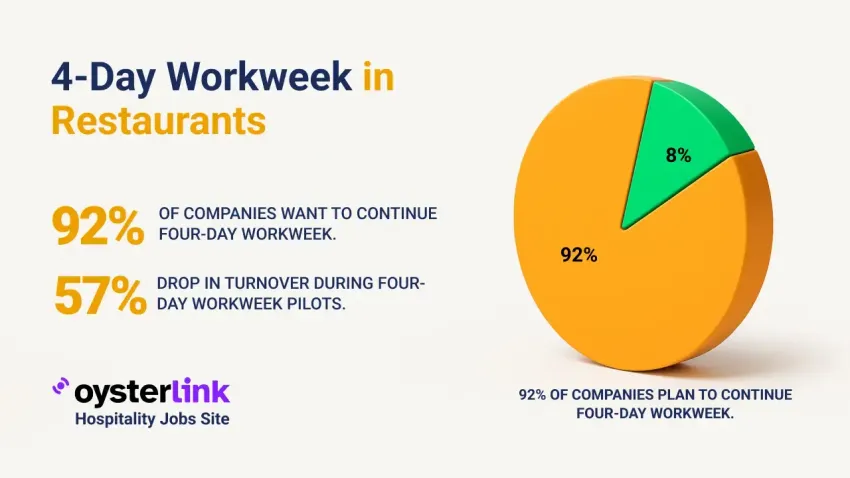





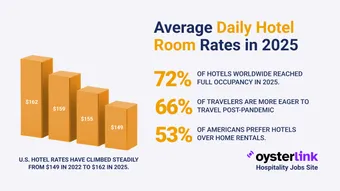



Loading comments...